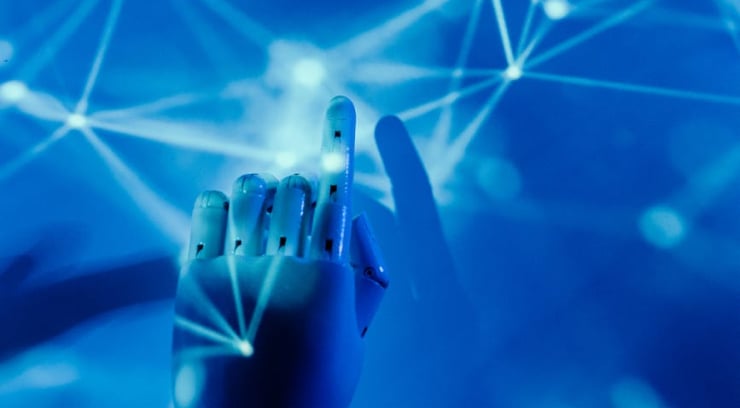- Home
- Artificial Intelligence
- AI Chatbots vs. Traditional Support: Which Is Better for Your Business?

When you’re running a business and a customer has a question. Do they need to wait on hold, or can they get an instant response? In today’s world, how you handle customer support can make or break your business. Customers want quick, efficient help, but they also value the human touch. The big question is: should you rely on traditional support methods, or is it time to embrace AI chatbots?
Customer support has evolved dramatically over the years. Traditional methods like phone calls and emails have been the backbone of customer service for decades. However, the rise of AI technology, particularly chatbots, is shaking things up. According to a report by Gartner, by 2025, AI will handle 95% of customer interactions, including live telephone and online conversations.
So, which option is better for your business—AI chatbots or traditional support? Let’s explore and compare these two approaches to help you decide.
What Is Traditional Customer Support?
Traditional customer support has been the go-to method for businesses for years. This approach includes familiar methods like phone calls, emails, and in-person interactions, where customers speak directly with a human representative. It’s the type of support most of us are used to—calling a helpline to speak with an agent or sending an email and waiting for a response.
One of the key strengths of traditional support is the personal touch. When customers talk to a live agent, they often feel heard and understood. This human connection can be crucial, especially when dealing with complex or sensitive issues. A skilled customer service agent can empathize with the customer, adapt their tone and approach, and provide personalized solutions that make the customer feel valued.
However, traditional support comes with challenges. For one, it’s often limited by business hours. If a customer needs help outside of these hours, they might have to wait until the next day to get a response. This can be frustrating, especially in a world where people expect instant solutions. Additionally, traditional support can be costly for businesses. Hiring, training, and maintaining a customer service team requires significant resources, especially if you need to scale up to handle a growing number of inquiries.
Despite these challenges, traditional support remains a strong option for businesses that prioritize human interaction and personalized service. But as customer expectations evolve, so too must the methods used to meet them.
What Are AI Chatbots?
AI chatbots represent a new era in customer support. These are computer programs designed to simulate human conversation using artificial intelligence. Unlike traditional support methods, AI chatbots can operate 24/7, providing instant responses to customer inquiries at any time of day.
One of the biggest advantages of AI chatbots is their speed. Customers no longer have to wait on hold or for an email response—they can get the information they need immediately. Chatbots are particularly effective at handling routine inquiries, such as answering frequently asked questions, providing order updates, or guiding customers through simple troubleshooting steps.
But AI chatbots aren’t just about speed; they’re also incredibly efficient. A single chatbot can handle thousands of inquiries simultaneously, something that would require a large team of human agents. This scalability makes chatbots a cost-effective solution for businesses, especially those experiencing rapid growth or dealing with high volumes of customer interactions.
Moreover, AI chatbots are becoming increasingly sophisticated. Thanks to advancements in machine learning and natural language processing, modern chatbots can understand and respond to complex questions more accurately than ever before. They can also learn from past interactions, continually improving their performance over time.
For example, companies like H&M and Domino’s have successfully integrated AI chatbots into their customer service strategies. H&M’s chatbot helps customers find the right products based on their preferences, while Domino’s chatbot allows customers to place orders through text messages or social media platforms. These examples highlight how AI chatbots can enhance the customer experience by providing quick, personalized service.
Comparing Speed and Availability
When it comes to customer support, speed and availability are crucial. Customers expect quick responses, and they want to be able to reach out for help at any time. This is where AI chatbots and traditional support methods differ significantly.

Traditional Support
Traditional customer support is typically limited by business hours. If a customer needs help at night or on weekends, they might have to wait until regular business hours to get a response. Even during business hours, customers might experience delays if the support team is dealing with a high volume of inquiries. Long hold times on phone calls or waiting days for an email response can lead to frustration and dissatisfaction.
AI Chatbots
AI chatbots, on the other hand, are available 24/7. They can provide instant responses to customer inquiries at any time, day or night. This constant availability is one of the biggest advantages of chatbots. Whether it’s a simple question about a product or a request for technical support, chatbots can handle it without delay. This means customers don’t have to wait for help, leading to a smoother, more satisfying experience.
For businesses, this around-the-clock availability can be a game-changer. It allows companies to provide consistent support across different time zones, catering to a global customer base. Additionally, by handling routine inquiries, chatbots can free up human agents to focus on more complex or urgent issues, improving overall efficiency.
Personal Touch vs. Automation
Personalization is a key factor in customer support. Customers appreciate feeling like they’re being treated as individuals rather than just another ticket in a queue. This is an area where traditional support methods often excel, but AI chatbots are catching up fast.
Traditional Support
Traditional support allows for a high degree of personalization. Human agents can adapt their responses based on the customer’s tone, mood, and specific needs. They can also build rapport with customers, offering empathy and understanding that a machine might struggle to replicate. This personal touch is particularly important in situations where customers are frustrated or dealing with complex issues that require nuanced solutions.
AI Chatbots
While AI chatbots are automated, they’re increasingly capable of delivering personalized experiences. By analyzing customer data—such as past interactions, purchase history, and preferences—chatbots can tailor their responses to each individual. For instance, a chatbot might recognize a returning customer and greet them by name, or it might recommend products based on their previous purchases.
Moreover, AI chatbots are designed to handle a wide range of inquiries, but they can also escalate issues to human agents when necessary. This hybrid approach ensures that customers receive personalized attention when it matters most, while still benefiting from the efficiency and speed of automation.
The choice between personal touch and automation depends largely on the nature of the customer inquiry. For routine questions and simple tasks, AI chatbots offer a fast, efficient solution. However, for more complex or sensitive issues, traditional support might be better suited to providing the empathy and human connection that customers value.
Cost Considerations
Cost is a significant factor when deciding between AI chatbots and traditional support. Both options have their own costs associated with them, but they differ in terms of how these costs impact the business.
Traditional Support
Traditional customer support can be expensive, especially as your business grows. Hiring, training, and retaining a customer support team requires ongoing investment. There are also costs associated with the tools and infrastructure needed to manage customer inquiries, such as phone systems, email platforms, and CRM software. Additionally, during peak times, you may need to hire additional staff or pay for overtime, which can further increase costs.
AI Chatbots
AI chatbots, on the other hand, require an initial investment in technology, including the cost of developing or purchasing a chatbot platform. However, once implemented, chatbots can significantly reduce operational costs. They can handle a large volume of inquiries without the need for additional staff, and they don’t require breaks, sick leave, or overtime pay. This makes them a cost-effective solution for businesses looking to scale their support operations without a corresponding increase in costs.
In the long run, AI chatbots can provide a strong return on investment (ROI) by improving efficiency, reducing labor costs, and enhancing customer satisfaction. However, it’s important to consider the specific needs of your business and customers when evaluating the cost-effectiveness of chatbots versus traditional support.
Adapting to Business Growth
As your business grows, so too does the demand for customer support. Whether you’re expanding into new markets, launching new products, or simply seeing an increase in customer inquiries, it’s crucial to have a support system that can scale with your business.

Traditional Support
Scaling traditional customer support can be challenging. As the number of inquiries increases, you’ll need to hire more staff, invest in additional training, and possibly expand your infrastructure to accommodate the larger team. This can be time-consuming and costly, and there’s always the risk of inconsistent service quality as you onboard new agents.
AI Chatbots
AI chatbots are highly scalable. Once your chatbot platform is set up, it can easily handle an increase in inquiries without the need for additional resources. Whether you’re dealing with 100 or 10,000 customers, the chatbot can manage the workload without any drop in performance. This scalability makes chatbots an ideal solution for businesses experiencing rapid growth or seasonal spikes in demand.
For example, during the holiday season, many e-commerce businesses see a significant increase in customer inquiries. A chatbot can help manage this surge by handling routine questions and requests, allowing human agents to focus on more complex issues. This ensures that all customers receive timely support, even during busy periods.
Conclusion
So, which is better for your business—AI chatbots or traditional customer support? The answer depends on your specific needs and goals. If your business handles a high volume of routine inquiries, operates in multiple time zones, or needs to scale quickly, AI chatbots offer a cost-effective, efficient solution. They provide instant, 24/7 support, helping to reduce costs and improve customer satisfaction.
On the other hand, if your business deals with complex or sensitive issues that require a personal touch, traditional support might be the better option. Human agents can offer empathy, build rapport, and provide tailored solutions that a chatbot might struggle to deliver.
In many cases, the best approach is a combination of both. AI chatbots can handle routine tasks and provide quick responses, while human agents step in for more complex issues. This hybrid model allows you to leverage the strengths of both AI and human support, ensuring that your customers receive the best possible service.
Ultimately, the key is to assess your business’s unique needs and choose the support strategy that aligns with your goals. By doing so, you’ll be well-positioned to meet the evolving expectations of your customers and stay ahead in a competitive market.


